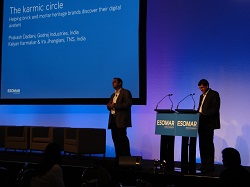Day 2 Conference report, compiled by:
– Steven Dunn
– Jaisurya Pavithran
Tuesday morning’s breakfast saw all the delegates recounting stories of their many wonderful and varied dining experiences from the night before – reconfirming Melbourne’s status as a “foodie heaven”.
First up on day 2 in the Main Hall was guest speaker Stephen Paton from the Australian Gas Light Company (AGL) who gave an interesting insight into a client perspective of market research. The relationships between energy companies and their customers have become incredibly complex as increased competition has given consumers far more choice and their views. Stephen explained how AGL has used market research to better understand their consumers and their value to the company. The insights derived from the research has led to widespread paradigm shift throughout AGL, benefiting both the company and their customers. Stephen provided a thought provoking presentation about the transformational power research has – but also added a cautionary note that many of the challenges that a research supplier faces, namely: cost, context, reliability and speed (the 4 Points of Pain!), are being faced equally within client companies, as their internal MR coordinators juggle the needs of their Marketing or Innovation, or other departments. In short, partnership is key!
The session on innovation imperatives started off with an introduction to the topic by session chair Suzanne Allen from Campbell Arnotts, Australia. Having tried her hand at a colorful canvas of professions – from working at a zoo to chairing a session at this conference, Suzanne was just the right person to talk about the multi-faceted nature of innovation – from innovation in ideas, to innovation in research, to innovation in product design.
And to help realize this innovation, Evette Cordy recommended the use of “Lead Users” – users who not only adopt new products before anyone else does, but also use them in ways not thought of before. Evette Cordy is the founder director of Raspberry Innovation Research + Strategy, Australia. Who is a “lead user”? What differentiates them from”early adopters”? How do we identify them? Why do some clients firms keep away from them, while others love them? These were just some of the many burning questions Evette answered in her presentation. She introduced a powerful yet very intuitive four-quadrant framework to identify lead users and the categories they fall into. The framework is a must-read for all market researchers who want to use the power of lead users in their research.
Sanja Burns from Givaudan, Singapore carried on with the topic of innovation by describing how the development of canned coffee in Japan was a clever innovation to realize two basic needs: The need to have coffee and the need for mobility. While Coffee flavor houses today seem to lean more towards objective methodologies, what is really required is an ear for subjective inputs from the consumer – what they really feel about the coffee. Since customers often express their coffee experiences in very colorful expressions, another important ingredient to better research is the study of semiotics amongst consumers. An innovative mix of subjective and semiotic approach to coffee flavor research will throw up insights on not just coffee flavors, but also on the complete consumer experience of having a cup of coffee.
After the coffee experience, Navin Williams from MobileMeasure, China and James Fergusson from TNS Global, Singapore got together to take the audience on the ‘mobile’ road to innovation – they described how mobile phones could be the next big thing in carrying out qualitative research in developing countries of Asia. The fact that mobile phones have become ubiquitous in developing countries such as India and China, and the fact that they allow for personalized access to consumers make mobile phones a promising medium for qualitative research. So how do you use this powerful Market Research medium to your advantage? Navin and James describe how in their paper “Bridging the digital divide in qualitative research in emerging markets”.
Carrying on the technology flavor in the innovation discussion, Prakash Dadlani from Godrej Industries, India and Kalyan Karmakar

from TNS, India took the online route to innovation in Market Research. Kalyan described the story of how Godrej Industries, one of India’s largest and oldest conglomerates had embarked on a mission to connect with the younger generation through social media sites. GoJiyo, the 3D virtual world developed by Godrej is a step in this direction. He also described how opening virtual online cafes on Facebook had helped Godrej to learn more about preferences of online consumers.
The discussion on innovation was wrapped up with a captivating presentation on how Air New Zealand had reinvented long-haul travel through insights from some very innovative Market Research techniques. Horst Feldhaeuser from Synovate and Hudson Smales from Air New Zealand took the audience through an elaborate market research exercise carried out for Air New Zealand that shifted the focus of the airlines from
“selling seats, to selling experiences”. What did the long haul flyers really want? How did Air New Zealand segment the long-haul travelers? How did Air New Zealand implement these findings? The paper “Flying with the Simpsons” talks about these and more.
Following lunch, Jennie Dunn & Erin Jancaukas hosted a World Café session….this provided some fantastic insights into further development and improvement opportunities for ESOMAR, and this will be publicized much more in the coming weeks, so watch this space !!


